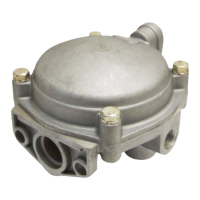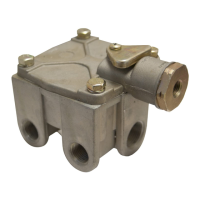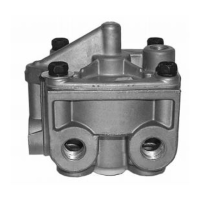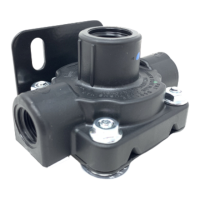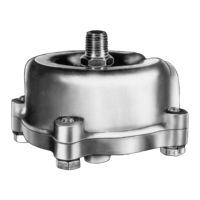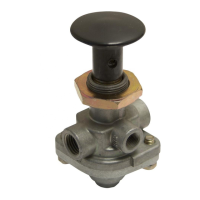4
RE-6
™
& RE-6NC
™
VALVES CHARGING HOLD
POSITION
In the RE-6
™
valve, as pressure increases in the reservoir,
the emergency piston is being pushed toward the seat on
the inlet and exhaust valve. When the emergency piston
reaches the seat of the inlet / exhaust valve, air is trapped
between the new seal and the chambers, holding the
chambers in the apply position. The check valve in the
RE-6
™
valve will continue to remain open, charging
the reservoir. In the RE-6NC
™
valve, air is acts on the
emergency piston, but there is still 0 psi in the reservoir
and the chambers. Air is also acting on the piston in the
PR-4
™
valve, but still has not reached the opening pressure
of 70 psi. Refer to Figure 5.
CHARGING THE RE-6
™
& RE-6NC
™
VALVES
ABOVE 60 PSI
In the RE-6
™
valve, as pressure increase beyond 60 psi, the
emergency piston and the inlet / exhaust valve, move from
the seat of the primary piston, opening the exhaust valve to
atmosphere allowing the service chambers to be exhausted.
The air will fl ow from the service chambers, back through
the RE-6
™
valve and out the exhaust of the RE-6
™
valve,
allowing drive away. In the RE-6NC
™
valve, air is still acting
upon the emergency piston, but there is no pressure in the
reservoir and the chambers. The emergency piston and
inlet / exhaust valve have moved to the exhaust position,
opening the exhaust portion of the valve to atmosphere.
The PR-3
™
valve remains closed until reaching 70 psi,
allowing air to fl ow to the reservoir. Refer to Figure 6.
CHARGING THE RE-6NC
™
VALVE ABOVE 70 PSI
Once system pressure reaches 70 psi, the PR-3
™
reservoir control valve will open charging the reservoir(s).
Simultaneously the emergency piston and inlet / exhaust
valve of the RE-6NC
™
valve is kept away from the seat
of the primary piston (keeping the exhaust valve open to
atmosphere). This is the major difference between the
RE-6
™
valve and the RE-6NC
™
valve. The RE-6NC
™
valve
allows for quicker drive away, since the reservoir does not
need to be fi lled before the brakes are released. Refer to
Figure 7.
RE-6
™
Relay Valve
RE-6NC
™
Relay Valve
RESERVOIR
45<>60 PSI
45<>60 PSI
CHAMBERS
HOLDING
EMERGENCY
SUPPLY
45<>60 PSI
0 PSI
0 PSI
45<>60 PSI
FIGURE 5 RE-6
™
& RE-6NC
™
RELAY VALVES CHARGING
HOLD POSITION
RE-6
™
Relay Valve
FIGURE 6 RE-6
™
& RE-6NC
™
RELAY VALVES CHARGING
ABOVE 60 PSI
RESERVOIR
60 PSI
CHAMBERS
0 PSI
EMERGENCY
SUPPLY
60 PSI
RE-6NC
™
Relay Valve
0 PSI
0 PSI
60 PSI
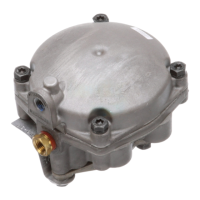
